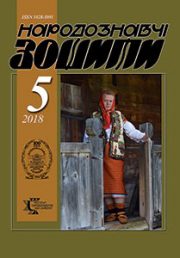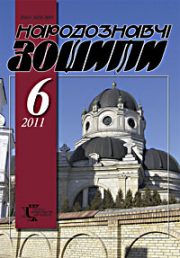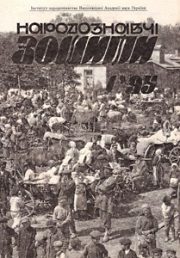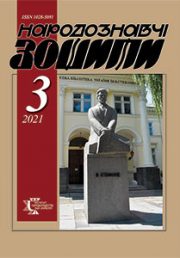The Ethnology Notebooks. 2019, № 6 (150), 1674—1683
UDK75.046.3:27-526.62]:623.431](477)”20″
DOI https://doi.org/10.15407/nz2019.06.1674
ART BETWEEN THE REAR AND THE FRONT. CONTEMPORARY UKRAINIAN ICONS ON AMMO BOXES
LESIV Andriy
ORCID ID: http://orcid.org/0000-0002-3408-7496
PhD in art studies, research fellow,
The Ethnology Institute
Of the National Academy of Sciences of Ukraine,
Art studies department.
15, Svobody ave, 79000, Lviv, Ukraine
e-mail: lesiv@nas.gov.ua
Abstract. The aim of the article: to highlight the artistic specificity of the unique phenomenon of modern Ukrainian sacred art — icons created on weapon boxes brought from the war zone in the East of Ukraine.
Actuality end novelty of the article. In this article first attempts to comprehensive study of the project «Icons on ammo boxes» from an artistic and socio-cultural point of view are made. The series of interviews were conducted with project creators — artists Olexandr Klymenko and Sofia Atlantova. On the basis of interviews, the prerequisites for the appearance of icons, their symbolism, iconography and social function were analyzed. «Icons on ammo boxes» project by selling icons supports the Pirogov First Volunteer Mobile Hospital, which brings medics to the war zone of eastern Ukraine. The project is inextricably linked to the theme of the Russian-Ukrainian War, it’s milestone events, to a history that is being created — which is why the authors of the project constantly emphasize in their stories not only the artistic component of the project, but also political and historical context.
The milestone ideas of the article. «Ilovaysk Deisis» is an important icon cycle from «Icons on Ammo Boxes» project. It consists of thirteen monumental icons painted on ammo boxes. The wood surface has not been processed or changed by the authors. They don’t use gesso; the painting lays directly on the wooden base. The stylistics of the painting of the «Ilovaysk Deisis» reminds of the children’s drawings in a certain way. Artists combine the traditional icon tempera painting with colored pencils and pastels. The body parts of the saints are painted with tempera; clothes are drawn with pencils and pastels, sometimes quite expressively, as if really imitating children’s drawings. Sometimes it seems that icons are created directly on the battlefront, in the field by using very simple materials — pencils, pens or pastels.
Another cycle of icons by Sofia Atlantova and Olexandr Klymenko is devoted to the iconography of «Passions». In this cycle authors avoid using colored pencils and pastels and use exclusively tempera colors instead. No gesso being used here, the painting lays directly on the wooden base. The colors of this cycle are slightly modified, dominated by muted, restrained shades, pigments are very light, translucent.
«Icons on Ammo Boxes» project are unique and has no analogues in the world. Sophia and Olexandr develop this project, feeling responsibility for the work of the mobile hospital, and in fact, for the lives of thousands of people the hospital helps every day.
Keywords: icon painting, icon, weapon boxes, ammo boxes, art, war, volunteering.
Received 5.11.2019
REFERENCES
Baudrillard, J. (2012). The Gulf War Did Not Take Place. Sydney: Power Publications.
Maksymenko, O. (2016). Icons painted on ammo boxes save lives. Cenzor. URL: https://censor.net.ua/ua/resonance/419655/ikony_napysani_na_yasyaschy_vid_naboyiv_ryatuyut_jyttya (Last accessed: 23.09.2019) [in Ukrainian].
We are fighting to make an icon from a weapon, not to turn an icon into a weapon. Heart to heart, 2019. URL: https://coradcor.us/news/my-boremosya-dlya-togo-shhob-zi-zbroyi-robyty-ikony-a-ne-ikony-peretvoryuvaty-na-zbroyu-v-filadelfiyi-vidkrylasya-unikalna-vystavka-ikon/ (Last accessed: 25.09.2019) [in Ukrainian].
Ryndych, I. (2015). Icons on ammo boxes: an unconventional approach to iconography in contemporary Ukrainian art. Relihijno-informatsijna sluzhba Ukrainy. URL: https://risu.org.ua/ua/index/exclusive/kaleidoscope/59583/ (Last accessed: 23.09.2019) [in Ukrainian].
Icons on… ammo boxes. Holos Ukrainy, 2502 [in Ukrainian].
Chehusova, Z. (2015). «Ilovaisk Deisys» by Sonia Atlantova and Oleksandr Klymenko. Kyiv: KalytaArtClub [in Ukrainian]
Pomerantsev, I. (2019). Icons by Sonia Atlantova and Oleksandr Klymenko on ammo boxes. Radio Svoboda. URL: https://www.svoboda.org/a/29965296.html (Last accessed: 27.09.2019) [in Russian].
Weigel, G. (2019). Icons on Ammo Boxes. Ethics & Public Policy Center. URL: https://eppc.org/publications/icons-on-ammo-boxes/ (Last accessed: 23.09.2019).
Klemensen, Olaf. (2015). Summer-ATO. Kyiv: Liuta Sprava [in Ukrainian].







